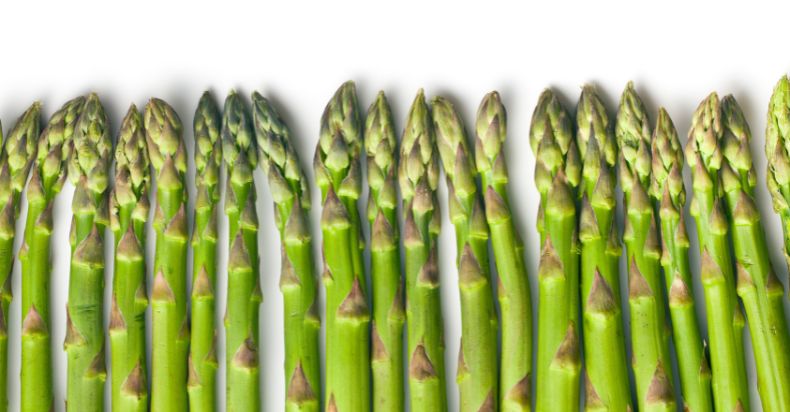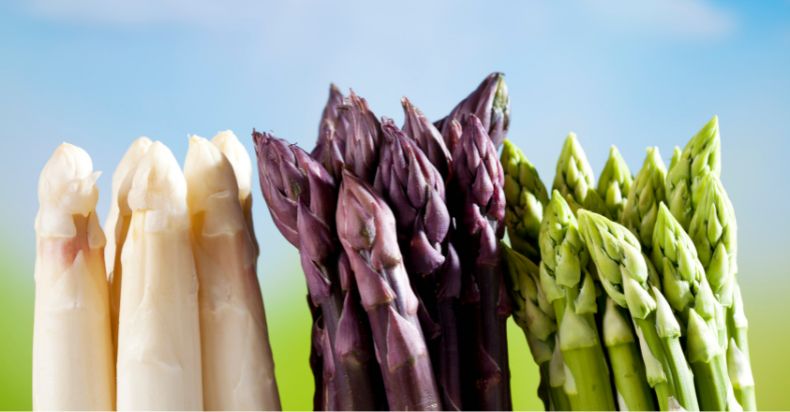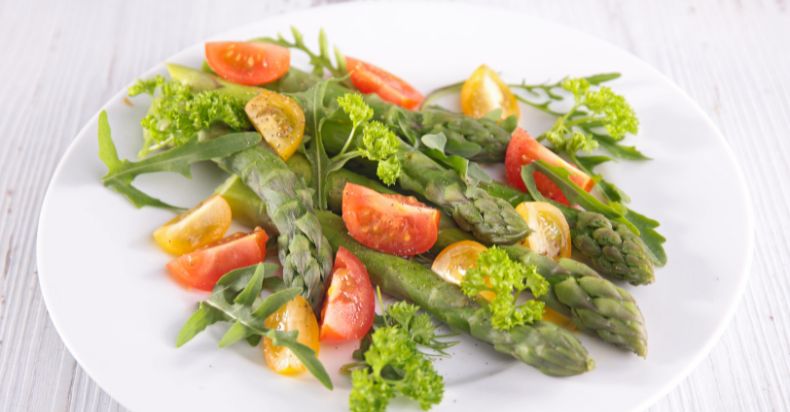In this guide, we’ll explore everything you need to know about asparagus. From its taste and nutritional content, to the best ways to cook and store it.
Quick summary:
- General Facts About Asparagus:
- Perennial plant with unique features like dark green feathery leaves.
- Cultivated worldwide, with China being the largest producer.
- Available in green, white, and purple varieties.
- Content and Health Benefits:
- Rich in fiber, vitamins, and antioxidants.
- Low in calories, aids in weight loss, and supports urinary tract health.
- Contains nutrients beneficial for skin, hair, bones, and mood.
- Rich in potassium and alkaline properties.
- The Taste of Asparagus:
- How to Cook and Serve Asparagus:
- Popular methods include roasting, steaming, and sautéing.
- Pairs well with various seasonings and can be served hot or cold.
- How to Store Asparagus:
- Can be refrigerated or frozen, with specific methods for fresh and cooked asparagus.
- Proper selection and storage techniques ensure freshness and quality.
What is Asparagus?

Asparagus, a member of the lily family, is a perennial plant that has captured the culinary world with its unique taste and appearance. Native to Asia and Europe, it has been cultivated and used in cooking for over two thousand years.
But what exactly is this intriguing vegetable that has become a staple in many kitchens around the globe?
The edible part of the asparagus plant is its stem, which can grow up to 20 cm long. These stems are solid, smooth, and erect, easily recognized by their dark green feathery leaves.
The plant also produces small, bell-shaped flowers that are greenish-white in color, along with small red fruit that is not edible.
Asparagus plants come in different colors, mainly green or white. The color variation depends on how they are cultivated. White asparagus is buried in the ground, preventing it from synthesizing chlorophyll, which accounts for its unique color.
Today, asparagus is cultivated worldwide, with China being the largest producer, providing more than three-quarters of the world’s supply.
Historical Background and Cultivation
The history of asparagus dates back to ancient times when it was originally used as an aphrodisiac. Its cultivation and culinary use have evolved over the centuries, and it has become a symbol of elegance and refinement in many cuisines.
Asparagus thrives in temperate climates and requires well-drained soil. The cultivation process is meticulous, often involving careful planting and nurturing to ensure the best quality stems.
The white variety, in particular, requires being buried in the ground to achieve its distinct color.
The popularity of asparagus has grown tremendously, not just for its unique taste but also for its numerous health benefits. It’s a vegetable that transcends cultural boundaries, finding its place in various dishes, from simple steamed preparations to gourmet recipes.
Types and Varieties of Asparagus:

Green Asparagus
Green asparagus is the most common type found in grocery stores and markets. Its vibrant green color is a result of exposure to sunlight, allowing it to synthesize chlorophyll.
This type of asparagus is known for its tender texture and slightly sweet, grassy flavor. It’s versatile in the kitchen and can be steamed, boiled, roasted, or grilled.
Green asparagus is often used in salads, stir-fries, and as a side dish to complement various main courses.
White Asparagus
White asparagus, often considered a delicacy in European cuisine, is cultivated by keeping the stalks buried in the ground, shielding them from sunlight. This prevents the formation of chlorophyll, giving the stalks their pale appearance.
White asparagus has a more delicate flavor compared to its green counterpart, with a hint of bitterness and a creamy texture. It’s typically peeled before cooking, as the outer layer can be tough to digest.
White asparagus is commonly served with hollandaise sauce or butter, highlighting its subtle taste.
Purple or Black Asparagus
Purple or black asparagus is a less common variety, known for its striking appearance and unique flavor profile. The color comes from an amino acid that causes the stalks to turn dark before harvesting.
Purple asparagus tends to be sweeter and more tender than the green variety, while black asparagus has a more intense, earthy flavor.
Some specific thick-stemmed varieties, such as Jersey Knight and York Imperial, are often used for soup stocks rather than as culinary vegetables. These types have a robust flavor that adds depth to soups and broths.
Nutritional Benefits of Asparagus
Low-Calorie and High-Fiber
Asparagus is a remarkable vegetable for those looking to maintain a healthy weight or shed some extra pounds.
With only around 22 calories in one cup, it’s a guilt-free addition to any meal. The high fiber content not only aids in digestion but also provides a feeling of fullness, helping to curb overeating.[source]
Rich in Vitamins and Minerals
- Vitamin K: Essential for bone health, asparagus is an excellent source of vitamin K, which helps in calcium absorption and blood clotting.
- Vitamins C and E: These antioxidants boost the immune system and protect the skin and hair, enhancing overall well-being.
- B Vitamins: Including folate, these vitamins are vital for energy production and can improve mood. Folic acid is particularly recommended for pregnant women to support fetal development.
- Potassium: This mineral helps regulate blood pressure and supports heart health.
- Chromium: A trace mineral that enhances the ability of insulin to transport glucose into cells, providing energy.[source]
Antioxidant Properties
Asparagus contains antioxidants like lycopene and beta carotene that counteract free radicals, protecting the body from cellular damage.
These antioxidants have been linked to a reduced risk of chronic diseases, including certain types of cancer.[source]
Diuretic and Alkaline Effects
The high water content in asparagus not only aids in weight loss but also has a diuretic effect, promoting urinary tract health.
Being one of the most alkaline foods, asparagus may also be beneficial for those with high blood pressure.
Enhancing Digestion
The fiber in asparagus not only keeps you full but also improves digestion by promoting healthy gut bacteria.
If bloating or digestive issues are a concern, incorporating asparagus into your diet can be a natural remedy. [source]
What Does Asparagus Taste Like?
Asparagus offers a unique taste that can be difficult to pin down. Its flavor is strong and distinct, often compared to other vegetables like mushrooms, broccoli, and green beans. However, asparagus stands out with a bolder taste that can be both bitter and sweet.
Green vs. White Asparagus
The taste of asparagus can vary depending on its color. Green asparagus tends to have a more robust flavor, while white asparagus, which is grown without exposure to sunlight, has a milder, more delicate taste.
The difference in cultivation methods leads to this variation in flavor, making each type a unique culinary experience.
Cooking Methods and Flavor Enhancement
- Baked: When baked and enhanced with lemon juice or olive oil, asparagus takes on a flavor that resembles beans but with a bolder twist.
- Steamed or Boiled: These methods preserve the natural taste of asparagus, allowing its unique flavor to shine.
- Raw: Consumed raw, asparagus offers a crunchy texture with an earthy taste that can be a delightful addition to salads.
The texture of asparagus adds to its unique taste experience. Raw asparagus can be crunchy or tender, depending on the size and thickness of the stalks.
When cooked, it becomes soft but retains a crisp coating, offering a pleasing contrast in every bite.
Asparagus pairs beautifully with various dishes, from grilled or steamed meats to seafood. Its strong flavor complements other ingredients without overpowering them, making it a versatile addition to many recipes.
The taste of asparagus is a culinary adventure that offers something new with every bite. Its strong, unique flavor, combined with various cooking methods and pairings, makes it a beloved vegetable for chefs and food enthusiasts alike.
How to Cook and Serve Asparagus?

Cooking Methods
1. Roasting:
- Preparation: Wash the stalks, remove scales, and cut off the bottoms. Preheat the oven to 400°F (205°C).
- Cooking: Lay the stalks on a parchment-lined baking sheet, season with salt and pepper, and roast for 15-20 minutes until browned but still crisp.
- Flavor Profile: Roasting brings out a sweeter, nuttier flavor, enhancing the natural taste of asparagus.
2. Steaming or Boiling:
- Preparation: Clean the asparagus and trim the ends.
- Cooking: Steam or boil until tender, usually 3-5 minutes for steaming and 5-7 minutes for boiling.
- Flavor Profile: This method retains the natural flavor and nutrients, offering a pure asparagus experience.
3. Sautéing:
- Preparation: Cut the asparagus into bite-sized pieces.
- Cooking: Sauté with oil and garlic until tender-crisp.
- Flavor Profile: Quick sautéing creates a delicacy with a rich garlic flavor.
4. Grilling:
- Preparation: Coat the asparagus with olive oil, salt, and pepper.
- Cooking: Grill over medium heat for 5-10 minutes, turning occasionally.
- Flavor Profile: Grilling imparts a smoky flavor, adding complexity to the dish.
5. Eating Raw:
- Preparation: Simply wash and trim the asparagus.
- Serving: Serve raw as an appetizer or in salads.
- Flavor Profile: Crunchy and fresh, raw asparagus offers an earthy taste.
Serving Suggestions and Pairings
1. As a Side Dish:
- With Meat: Grilled or steamed asparagus pairs wonderfully with grilled or steamed meats.
- With Fish: Try serving with baked or grilled fish for a light and healthy meal.
2. In Salads:
- With Citrus: Mix with citrus fruits like lemon or orange for a refreshing salad.
- With Nuts: Add almonds or walnuts for a crunchy texture.
3. As a Main Course:
- In Pasta: Incorporate into pasta dishes with garlic, olive oil, and Parmesan.
- In Risotto: Create a creamy asparagus risotto for a comforting meal.
4. As an Appetizer:
- Wrapped in Prosciutto: Wrap asparagus in prosciutto and roast for a delightful starter.
- With Dipping Sauce: Serve steamed asparagus with a hollandaise or aioli sauce for dipping.
Cooking and serving asparagus can be as simple or as elaborate as you like. From roasting to eating raw, there are numerous ways to enjoy this versatile vegetable. Pairing it with different ingredients and using various cooking methods allows you to create dishes that suit any occasion.
How to Store Asparagus
Storing Fresh Asparagus
1. Refrigeration:
- Short-Term Storage: If you plan to use the asparagus within two weeks, refrigerate it. Place the stalks upright in a glass with an inch of water, covering them with a plastic bag. Alternatively, wrap the ends in a damp paper towel and place them in a plastic bag.
- Avoid Ethylene Gas: Keep asparagus away from fruits and vegetables that emit ethylene gas, like apples and tomatoes, as it can accelerate ripening.
2. Freezing:
- Blanching: Before freezing, blanch the asparagus by boiling it for 1-2 minutes and then immediately plunging it into ice water. This helps retain color, flavor, and nutritional value.
- Packing: Dry the blanched asparagus and pack it in airtight freezer bags or containers.
- Long-Term Storage: Frozen asparagus can be stored for up to one year.
Storing Cooked Asparagus
1. Refrigeration:
- Cooling: Allow cooked asparagus to cool to room temperature.
- Packing: Place in an airtight container or wrap tightly in aluminum foil or plastic wrap.
- Usage: Use within 3-4 days for the best quality.
2. Freezing:
- Cooling: Let the cooked asparagus cool completely.
- Packing: Place in airtight freezer bags or containers, separating layers with parchment paper if needed.
- Usage: Use within 10-12 months for optimal flavor.
Tips for Selecting and Storing Asparagus
1. Selection:
- Look for Freshness: Choose firm, well-shaped stalks with tightly closed tips. Avoid stringy, tough, or dried-out stalks.
- Check Color: Opt for green asparagus with no yellowing to ensure peak ripeness.
2. Avoiding Common Mistakes:
- Don’t Store with Ethylene-Producers: As mentioned, keep away from ethylene-producing fruits and vegetables.
- Don’t Freeze Without Blanching: Blanching is essential for preserving the quality of asparagus before freezing.
Storing asparagus properly ensures that you can enjoy this delicious vegetable at its best, whether you plan to use it within a few days or over the course of a year. By following these guidelines for refrigeration, freezing, and selection, you can maximize the flavor, texture, and nutritional benefits of asparagus.
Final Thoughts:
Asparagus, a vegetable that has graced culinary traditions for over two thousand years, is more than just a tasty side dish. It’s a powerhouse of nutrients, a versatile ingredient, and a fascinating plant with a rich history.
From its unique taste to its myriad health benefits, asparagus has become a favorite among chefs and health enthusiasts alike.
